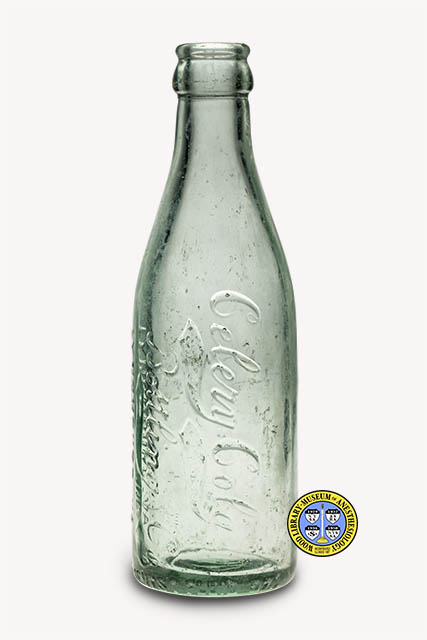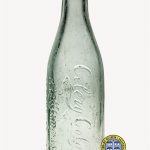Celery Cola
Celery has been cultivated for food and medicine since ancient times. It has been used as a diuretic, a sedative, a headache remedy, an anti-inflammatory and a treatment for high blood pressure. All these effects are of interest to anesthesiologists, whose work includes management of the patient's body fluids during surgery, and pain medicine.
The English scientist Rev. Joseph Priestly (1733-1804) discovered nitrous oxide and was a co-discoverer of oxygen. In 1772 he published a method of carbonating water. Two years later, his countryman John Mervin Nooth (1737-1828) introduced a glass carbonating apparatus. In 1846, a Nooth Apparatus was modified to make the Hooper Ether Inhaler, one of the first inhalers for modern surgical anesthesia in the world.
The soft drink, Celery Cola, was concocted by James C. Mayfield. He used techniques learned from his former partner, John Pemberton (1831-1888), who was the creator of Coca-Cola. Celery Cola was manufactured from 1899 to 1910. The product was taken off the market due to a suit brought by the Federal government that proved the beverage also contained cocaine and caffeine, which was not disclosed on the label. The Coca-Cola Company later sued Mayfield for Trade Mark infringement.
Catalog Record: Celery Cola Celery Cola
Access Key: aqsm
Accession No.: 2009-04-01-1
Title: Celery cola.
Author: Mayfield, James C.
Corporate Author: Celery Cola Bottling, Inc.
Publisher: Lynchburg, Virginia : Celery Cola Bottling, Inc., [between 1899 and 1910].
Physical Description: 1 botte : glass ; 20 x 5.5 diameter cm.
Subject: Analgesics, Non-Narcotic.
Subject: Apium graveolens.
Subject: Carbonated Beverages.
Note Type: General
Notes: The range of possible dates of manufacture is based on the earliest and latest dates that the product was made. The actual first year of production is likely to have been somewhat later.
Ketchum defines a “blob top” as a “heavy knoblike glass top designed to support closure on mineral or soda water bottles” (p. 215.)
Note Type: Citation
Notes: Bhamwiki.com website. http://www.bhamwiki.com/w/Celery-Cola. Accessed December 18, 2017.
Note Type: Citation
Notes: Drugs.com website. https://www.drugs.com/npp/celery.html. Accessed May 2, 2018.
Note Type: Citation
Notes: Ketchum WC. A treasury of American bottles. New York : A & W Visual Library, 1975.
Note Type: Citation
Notes: Kolawars.com website. http://kolawars.com/celerycola.html. Accessed December 18, 2017.
Note Type: Citation
Notes: Zuck D. Dr Nooth and his apparatus. Brit J Anaesth. April, 1978;50(4):393-405.
Note Type: Physical Description
Notes: One bottle made of thick, blue-green or aqua glass; The body of the bottle is embossed above the mold seam, lengthwise, in cursive script: “Celery Cola [new line] Bottling [new line] INC. [new line] LYNCHBURG, VA”; The bottom edge of the bottle is embossed: “CONTENTS 7 FLUID OZ.”; This text wraps under the heel; The bottle has a bulbous finish (called a “blob top”) with a well-defined rim or lip; The opening is approximately 1.5 centimeters in diameter; There are two chips in the finish on the side opposite to that which is embossed; There are also various flaws, scratches and soil and/or salt deposits in the glass.
Note Type: Reproduction
Notes: Photographed by Mr. Steve Donisch, January 17, 2018.
Note Type: Historical
Notes: Celery (Apium graveolens), a plant native to Europe, has been cultivated for food and medicine since ancient times. In the late 19th and early 20th centuries celery was an ingredient in many patent medicines. Parts of the plant have been used as a diuretic, a sedative, a headache remedy, an anti-inflammatory and a treatment for high blood pressure. All these effects are of interest to anesthesiologists, whose work includes the management of body fluids during surgery, as well as pain medicine.
The English scientist Rev. Joseph Priestly (1733-1804) discovered nitrous oxide gas and was a co-discoverer of oxygen. While pursuing his experiments, he discovered a method of carbonating water. He published his method in 1772. Two years later, his countryman John Mervin Nooth (1737-1828) introduced a glass carbonating apparatus. In 1846, a Nooth Apparatus was modified to make the Hooper Ether Inhaler, one of the first inhalers for modern surgical anesthesia in the world.
Large-scale manufacture of carbonated water began in the 1880s. The soft drink, Celery Cola, was concocted by James C. Mayfield, using the techniques developed by his former partner, John S. Pemberton (1831-1888), the creator of Coca-Cola. Originally located in Birmingham, Alabama, Mayfield’s company also had branches and franchises in several other cities. Celery Cola, was manufactured from 1899 to 1910. The product was taken off the market due to a suit brought by the Federal agency that later became the Food and Drug Administration. It was proved that the beverage contained cocaine and caffeine, which was not disclosed on the label. Four years later the Coca-Cola Company sued Mayfield for Trade Mark infringement, and won their case in 1920.
Note Type: Exhibition
Notes: Selected for the WLM website.


